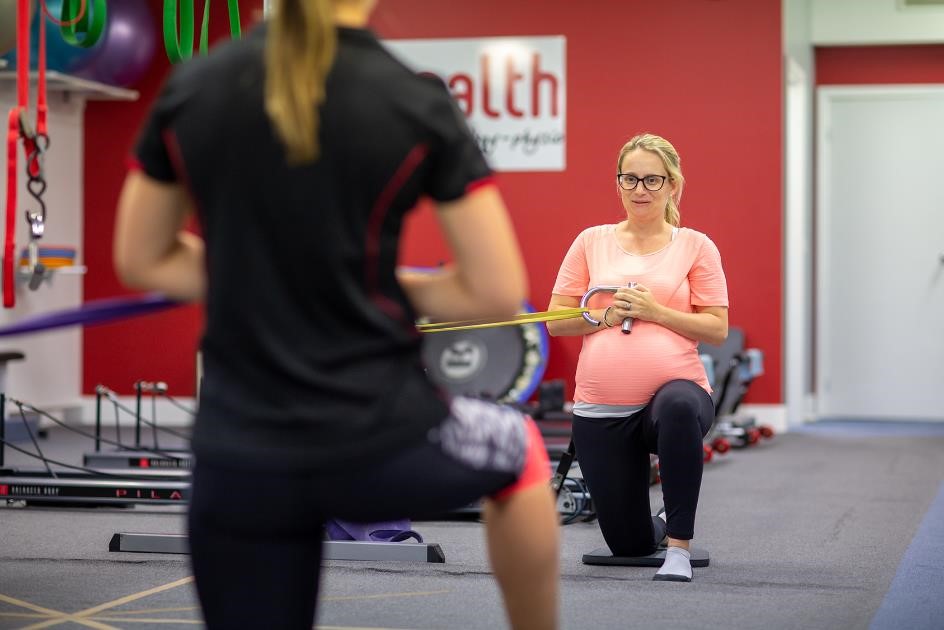After years of experience and taking many women through exercise during their pregnancy, from initial stages all the way to just before birth, there are 2 major physical issues that seem to have the biggest impact on women’s quality of life and pain during and after pregnancy, and these include:
• Pelvic girdle pain (Pelvic instability)
• Mid back pain
In general, both these issues are well managed with exercise, especially if you start exercise in the early stages of pregnancy and will have a dramatic impact on the way you will feel post childbirth
Pelvic girdle pain (pelvic instability)
During pregnancy, a specific hormone, relaxin, is released from fairly early in the pregnancy that makes the ligaments around the pelvis and the pubic bone area “loosen” in preparation for childbirth.
Usually, the ligaments around the pelvis (around the sacroiliac joint, the small, flat joint between your sacrum (your tailbone area) and your pelvis bone area (the large bony structure that links your hips to your spine and protects the pelvic organs) are some of the most stable and strongest ligaments in your body. They rarely move more than 1-2 millimetres and can take a lot of load, transferring force between you hips and your spine and vice versa between your spine and your hips.
Similarly, at the front of the pelvis, between the 2 pubic bones sits a very strong cartilage structure called the pubic symphysis. It transfers force from one side of the body to the other and absorbs shock. Again, it is usually very stable and rarely moves more than a couple of millimetres, except during pregnancy and childbirth.
The major support muscles around the pelvis are the gluteal muscle groups, in particular, the gluteus maximus muscle, a very strong muscle responsible for extending the hips and extending the spine when lifting and carrying. Normally, prior to pregnancy, most women can get away with having weakness in the gluteal muscles because these ligaments are naturally very strong and can take a lot of load, however, as pregnancy progresses and these ligaments become looser as a result of relaxin, the job required of the gluteal muscles groups becomes larger to provide support. Weakness of these muscles increases the load on the loosening ligaments, which contain a significant number of nerve fibres and can cause pain. Pain in the buttock and back area due to pelvic instability can start off quite mild in the early stages and progress further as the pregnancy comes along.
Pain is particularly present when walking, going up and down stairs and when walking up and down hills. Unfortunately, after childbirth, although relaxin levels reduce, control around the pelvis does not automatically go back to the level it was before pregnancy without directly working on the strength and control of the gluteal muscle groups.
The great news is that, most often, you can do something about it. You can work on your strength by making your gluteal muscles strong, from ideally before your become pregnant, when you are still trying or during pregnancy.
Over the years we have seen enormous changes in the quality of life and pain levels of women who have worked on the strength of these muscles during pregnancy compared to those who have not. In particular, we have seen big changes in how women have coped with their second pregnancy (when they decided to work on their pelvic stability) compared to their first pregnancy, where they have not. And, the earlier the better to give your body the chance to build up as much strength for childbirth and beyond.
Midback pain (Thoracic pain)
Although this occurs mostly after childbirth, mid back pain can often start during pregnancy. The most common reason after birth is due to breastfeeding, expressing or repeatedly lifting and carrying your baby.
This puts a large and repeated load on the mid back area and the arms, which commonly leads to pain.
Again, the solution is relatively simple, make the area strong enough to cope with the load required.
During pregnancy is a great time to work on the strength of the upper body postural muscles (the stabilisers of the mid back and shoulder blades) and your arm strength. It can be easily underestimated, the importance of building up your arm strength during pregnancy, but pays enormous benefits after childbirth.
Where do you start?
Start your strengthening exercise program as early as possible during your pregnancy, as soon as it is safe to do so.
If you have already been exercising prior to becoming pregnant, you can usually continue to do so with minimal restriction. However, if you are new to exercise and want to start during pregnancy, you will need a specific clearance from your obstetrician to ensure that you are safe to commence.
Click here for: Guidelines for physical activity during pregnancy
Do you have any questions?
- Call us on (03) 9857 0644 or (07) 3505 1494 (Paddington)
- Email us at admin@mdhealth.com.au
- Check out our other blog posts here
Our clinical staff would be happy to have chat if you have any questions.



